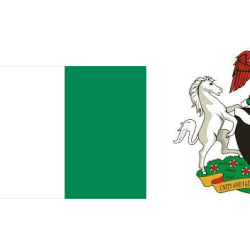The largest state in Nigeria by land area is Borno. It has a land area of 72,767 Km². Borno has a wide expanse of land stretching from Lake Chad down to Adamawa, making it the biggest state in Nigeria. It is followed Niger State.
The state with the smallest land area is Lagos which has 3,475 Km².
Nigeria’s total land mass is 911,519 Km².
The 10 largest states of Nigeria by land area are:
- Borno
- Niger
- Taraba
- Bauchi
- Yobe
- Kaduna
- Adamawa
- Kebbi
- Kwara
- Zamfara
Full list of Nigeria states land size. From largest to smallest
| State | Area (Km²) |
|---|---|
| Borno | 72,767 |
| Niger | 72,065 |
| Taraba | 59,180 |
| Bauchi | 48,197 |
| Yobe | 44,880 |
| Kaduna | 44,217 |
| Adamawa | 37,957 |
| Kebbi | 36,320 |
| Kwara | 33,792 |
| Zamfara | 33,667 |
| Sokoto | 32,146 |
| Benue | 30,755 |
| Kogi | 29,063 |
| Oyo | 27,036 |
| Nasarawa | 26,633 |
| Plateau | 26,539 |
| Katsina | 23,822 |
| Jigawa | 23,415 |
| Cross River | 22,112 |
| Kano | 20,389 |
| Edo | 19,584 |
| Gombe | 17,428 |
| Delta | 17,095 |
| Ogun | 16,850 |
| Ondo | 15,019 |
| Rivers | 10,361 |
| Bayelsa | 9,363 |
| Osun | 8,585 |
| Federal Capital Territory, Abuja | 7,569 |
| Enugu | 7,560 |
| Akwa Ibom | 6,788 |
| Ebonyi | 6,342 |
| Ekiti | 5,797 |
| Imo | 5,135 |
| Abia | 4,857 |
| Anambra | 4,761 |
| Lagos | 3,475 |
| Total | 911,519 |
Highlights of Borno, Nigeria’s biggest state
The largest state in Nigeria by land area is Borno State, covering an impressive 72,767 square kilometers. This expansive territory stretches from Lake Chad in the northeast down to the Adamawa border in the south, making it not only the largest state geographically but also a region of significant strategic and cultural importance in Nigeria.


Borno’s size and its location at the crossroads of Nigeria’s borders with neighboring countries make it a critical region for trade, agriculture, and diplomacy. Its vast land area offers potential for economic growth, particularly in agriculture and natural resource management.
- Geographical Position:
- Located in the northeastern region of Nigeria, Borno shares borders with three countries: Niger, Chad, and Cameroon.
- Its vast land area encompasses diverse terrains, including the arid Sahel region, parts of the Lake Chad basin, and savannah grasslands.
- Historical and Cultural Significance:
- Borno is home to the Kanem-Borno Empire, one of the oldest and most influential empires in African history.
- The state capital, Maiduguri, is often referred to as the “Home of Peace” and serves as a cultural hub in the region.
- Economic Importance:
- The Lake Chad basin is a crucial agricultural and fishing resource, supporting local livelihoods despite challenges posed by shrinking water levels.
- Borno is also known for livestock farming and traditional crafts.
- Challenges and Resilience:
- In recent years, the state has faced challenges due to insurgency, impacting its communities and infrastructure. However, ongoing efforts by the government and international organizations aim to rebuild and restore stability in the region.
Map of Nigeria’s 36 states & Abuja (the Federal Capital Territory)

States creation, reformation
By the time that Nigeria got independence it was a federation of the three regions, namely:
Western
Eastern
Northern
Later on another region was added, the Mid-Western Region.
The Mid-Western Region was formed from the Western Region in 1966, and Lagos, the capital, was effectively governed as an unofficial fourth region outside the bounds of the Western Region.
This brought the number of regions to 4 as follows:
Western
Mid-Western
Western
Northern
Under the short-lived military government of Aguiyi-Ironsi, Nigeria was reorganized under a central government. Following a coup which resulted in Aguiyi-Ironsi’s deposition and assassination, Nigeria was reorganized as a federal country again with three of the regions being divided into newer entities and all first-level subdivisions being renamed as states.
Western Region was divided into:
Lagos
and Western states.
Eastern Region was divided into:
East-Central,
Rivers,
and South-Eastern states;
Northern Region was divided into:
Benue-Plateau,
Kano,
Kwara,
North-Central,
North-Eastern,
and North-Western (Sokoto) states
1976 reformation of Nigeria’s federating units
In 1976, six years after the end of the civil war, the states were further reorganized:
State boundaries and names were also reorganized.
Benue-Plateau state divided into:
Benue
and Plateau states.
East-Central state divided into:
Anambra
and Imo states.
Federal Capital Territory (Abuja) formed from parts of Niger and Plateau states.
North-Eastern state divided into:
Bauchi,
Borno,
and Gongola states.
Niger (Minna) state split from Sokoto.
Western state divided into:
Ogun,
Ondo,
and Oyo states
States of Nigeria from 1987-1991
Akwa Ibom state created from Cross River;
Katsina state created from Kaduna
States of Nigeria from 1991-1996
Abia State created from Imo;
Bendel State divided into Delta and Edo;
Enugu State created from Anambra;
Gongola State divided into Adamawa and Taraba;
Jigawa State created from Kano;
Kebbi State created from Sokoto;
Kogi State formed from parts of Benue and Kwara;
Osun State created from Oyo;
Yobe State created from Borno.
States of Nigeria from 1996
Bayelsa State created from Rivers;
Ebonyi State was formed from parts of Abia and Enugu;
Ekiti State created from Ondo;
Gombe State created from Bauchi;
Nasarawa State created from Plateau;
Zamfara State was created from Sokoto.







